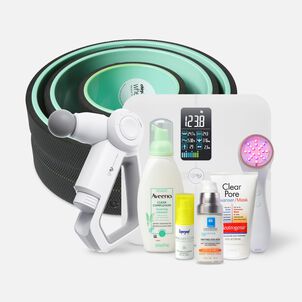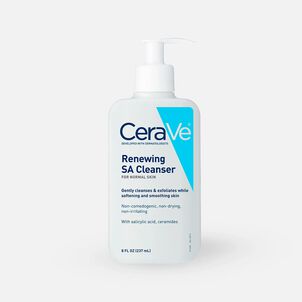Tips on How to Exfoliate Your Face

If you're reading this, you probably already know that skin care isn't always a one-size-fits-all kind of thing. Everyone's skin type is different, which may lead to entirely different skin care routines altogether. And when it comes to practices like exfoliation, there's a right and a wrong way to do it, so we've put together solid tips on how to exfoliate your face so you can be one step closer to healthy skin.
Shed the dead
Exfoliation does exactly what you think it does: removes the dead skin cells from the outer layer of your skin. But before you go scrubbing away, there's actually quite a few factors you should take into consideration when exploring the benefits of exfoliating your skin.
First and foremost, you should think about your skin type. According to the American Academy of Dermatology Association (AADA), the need for and type of exfoliation depends on your skin type. Whether you have sensitive skin that stings or burns after product use, normal skin that is clear and not sensitive, dry, itchy, or flaky skin, oily and greasy skin, or combination skin which is (you guessed it) both oily and dry in certain areas, you will have to decide which exfoliator will work with your skin, and not against it.
Different types of exfoliators
This is especially important to keep in mind when thinking about your skin type and preventing further damage. Think about it like choosing a jacket: if it's cool and windy outside, you might want to wear a windbreaker. If there are sub-freezing temperatures, you will want something thick and heavy, potentially with down or wool. Each jacket serves its own purpose depending on the weather, and you would never consider mixing those up. The same goes for exfoliating - there's a purpose behind each type of exfoliator.
Mechanical vs. Chemical
These terms may sound intimidating, but don't fret. Mechanical exfoliation it's the approach of literally scraping away useless, dead skin with an abrasive substance according to FutureDerm. This is likely the most common form of exfoliation seen across mainstay products from apricot scrubs to sugar scrubs, and even exfoliating brushes and sponges. We'll get to those products in just a bit.
Chemical exfoliation, on the other hand, uses a bit of a heavier-handed approach, but not literally. The AADA states that chemical exfoliators actually dissolve the dead skin cells using dermatologist-approved ingredients like beta hydroxy acid and alpha hydroxy acid. These ingredients work away at the dead skin cells chemically to "peel" away the unwanted skin, hence the term chemical peel.
Tip #1: Match your skin type with exfoliation type
Now that you know your skin type and the types of exfoliators, let's see which combinations work best together. Your first job is to check the ingredients! Always look at the ingredients used in the exfoliator so you know which is right for you.
- Dry or sensitive skin: Mild chemical or soft mechanical exfoliators
Keep in mind that your skin is sensitive! Mechanical exfoliators may be too harsh on your skin. FutureDerm suggests a mild chemical exfoliator made from alpha hydroxy acids - or more commonly, glycolic or lactic acids - as they are naturally occurring compounds. For sensitive skin, even a light brushing with a washcloth or sponge can do the trick without irritating your skin.
- Oily and acne-prone skin: Chemical exfoliator
Oily skin creates an extra barrier for the product to work through and begin to remove the dead skin cells. Sources at FutureDerm say that chemical exfoliators with beta hydroxy acids are oil-soluble which means it can penetrate deeper and remove the bacteria and dead skin. You may have heard of salicylic acid. Yea, that's the one!
- Combination skin: Chemical and mechanical exfoliator
This may seem obvious, but that's because it is! On the oily parts of your skin, it may be best to use a chemical exfoliator whereas on the dry parts, a mild mechanical exfoliator like a face scrub would do the trick, so you can get a handle on both spectrums.
- Dark skin: Avoid strong chemical and mechanical exfoliators
According to the AADA, excessive exfoliation on darker skin tone may result in dark spots on the skin. Apply this general rule of thumb to whichever exfoliator type best matches your skin type above.
Tip #2: Rougher is NOT better
Everyone has this crazy notion that the harder you scrub, the better job you have done at exfoliating. This couldn't be farther from the truth! Be gentle with your skin. Dermatologists recommend the following:
Use the chosen product in small amounts and apply in a circular motion for 30 seconds, then wash with tepid water. If using a towelette or sponge to exfoliate sensitive skin, use small, light strokes so not to irritate the skin.
Pro-tip: Never exfoliate skin that is sunburned or damaged.
Tip #3: How often should I exfoliate?
This certainly depends on your skin type and how strong of an exfoliator you're using. According to Healthline, normally two to three times per week should suffice, but if you have more sensitive skin, you might want to lean more towards one to two times per week.
Over-exfoliating can result in drying out the skin, and in some cases, cause your skin to over-produce oil, which can clog pores, trap bacteria, and cause acne.
Tip #4: Finish the job
Think of washing a car (last analogy, we promise). When you remove all of the dirt and dust from the car, the paint is now vulnerable to more dirt and dust and outdoor elements like rain and the sun's harsh rays. Now's the time to apply the finishing touches.
Step 1: Moisturize and protect - Neutrogena says exfoliation brings your fresh skin to the surface which is at its freshest and most-vulnerable state, so protect it! Moisturizing treatments and broad-spectrum sunscreen are your skin's best friends. Find which sun protection factor (SPF) is right for you and your skin types, including ones that are noncomedogenic, or non-pore clogging. Best part? Ours are all guaranteed eligible.
Step 2: Don't go overboard - Refer to tip #3 on this one, but also, be careful about which ingredients and types of exfoliators you are choosing from charcoal to sugar, pumice, and other aggregates. Bigger and rougher scrubs are not always better.
Thanks for visiting the FSA Learning Center! To stay on top of all FSA news that can affect your health and financial wellness, be sure to follow us on Facebook and Twitter.
















